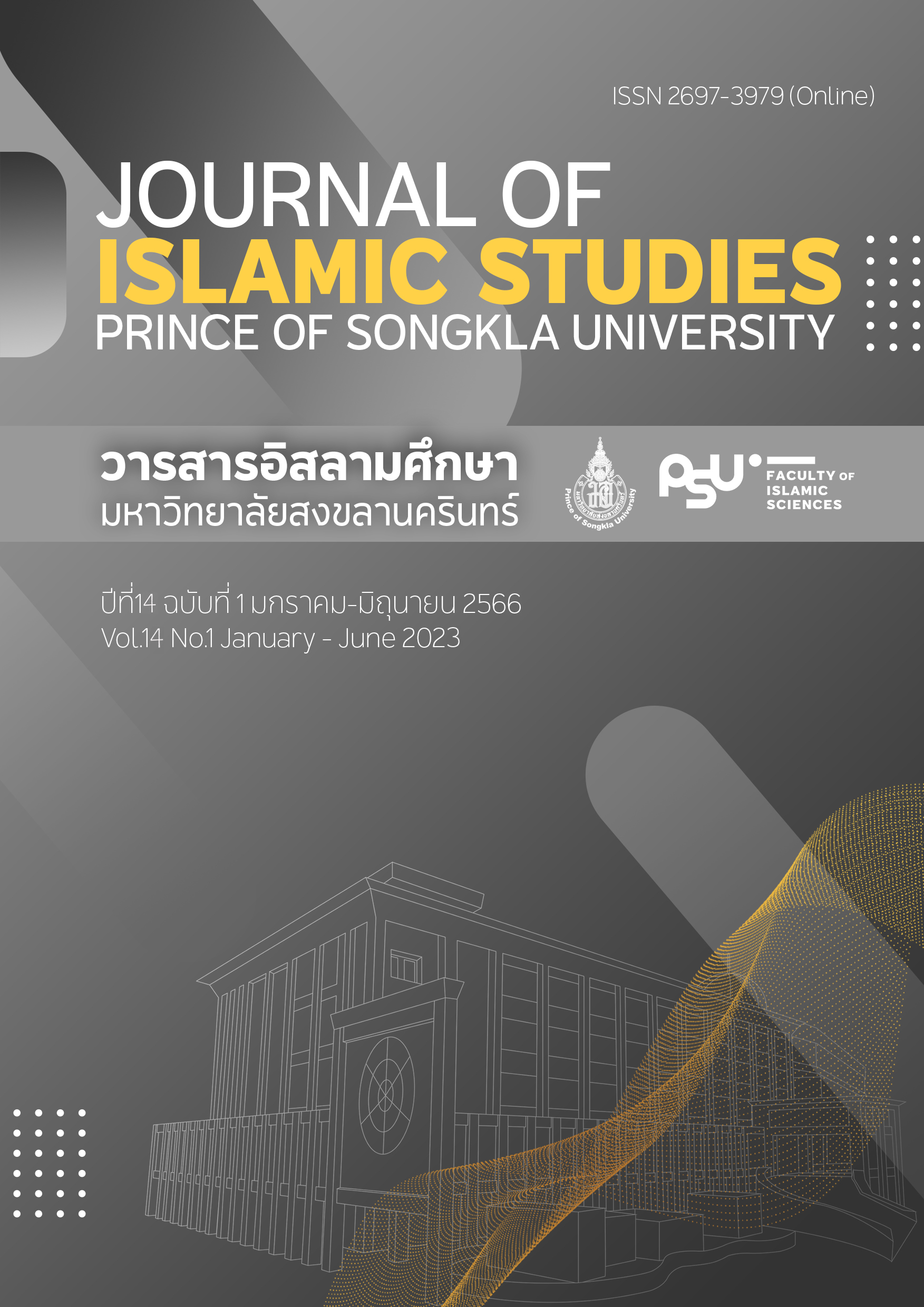ศึกษาวิเคราะห์มุมมองนักศึกษาต่อศิฟัตสัลบียะฮ์ในหนังสือฟะรีดะตุลฟะรออิด ของเชคอะห์มัด อัลฟาฏอนีย์ ตามหลักการวะสะฏียะฮ์
คำสำคัญ:
นักศึกษา, ศิฟัตสัลบียะฮ์, วะสะฏียะฮ์บทคัดย่อ
วัตถุประสงค์ 1) เพื่อศึกษาวิเคราะห์ความเข้าใจของนักศึกษาคณะวิทยาการอิสลาม มหาวิทยาลัยสงขลานครินทร์ วิทยาเขตปัตตานี ที่มีต่อศิฟัตสัลบียะฮ์ในหนังสือฟะรีดะตุลฟะรออิด 2) ศึกษาวิเคราะห์ความสัมพันธ์ระหว่างหลักวะสะฏียะฮ์กับความเข้าใจ ศิฟัตสัลบียะฮ์ของนักศึกษาคณะวิทยาการอิสลาม มหาวิทยาลัยสงขลานครินทร์ วิทยาเขตปัตตานี
วิธีการศึกษา การศึกษาใช้วิธีการวิจัยเชิงคุณภาพ โดย ประชุมเชิงปฏิบัติการเพื่อระดมความคิด และการสนทนากลุ่มนักศึกษาที่มีต่อศิฟัตสัลบียะฮ์ในหนังสือฟะรีดะตุลฟะรออิด ของเชคอะห์มัด อัลฟาฏอนีย์ กลุ่มเป้าหมายเป็นนักศึกษาคณะวิทยาการอิสลาม ชั้นปีที่ 3 ปีการศึกษา 2565 จำนวน 93 คน จากกลุ่มนักศึกษา 4 สาขาวิชา ได้แก่ อิสลามศึกษา การสอนอิสาลามศึกษา เศรษฐศาสตร์และการจัดการในอิสลาม และกฏหมายอิสลาม และคัดเลือกแบบเจาะจง 30 คน ทำการวิเคราะห์ข้อมูล โดยการวิเคราะห์เชิงเนื้อหา
ผลการวิจัย พบว่า 1) นักศึกษามีความเข้าใจต่อศิฟัตสัลบียะฮ์ในหนังสือฟะรีดะตุลฟะรออิด ของเชคอะห์มัด อัลฟาฏอนีย์ ซึ่งเกิดจากปัจจัยการศึกษาพื้นฐาน ตั้งแต่การศึกษาในระดับตาดีกา อิบติดาอีย์ มุตาวัสสิต ซานาวีย์ จนถึงมหาวิทยาลัย 2) นักศึกษามีความเข้าใจศิฟัตสัลบียะฮ์ที่สอดคล้องระหว่างเนื้อหาในหนังสือฟะรีดะตุลฟะรออิด ของเชคอะห์มัด อัลฟาฏอนีย์ หลักฐานอักลีกับนักลี 3) นักศึกษามีการยอมรับต่อศิฟัตสัลบียะฮ์ในหนังสือฟะรีดะตุลฟะรออิด ของเชคอะห์มัด อัลฟาฏอนีย์ ทั้งหลักฐานที่เป็นอักลี (‘Akli) และนักลี (Nakli) ซึ่งบ่งบอกถึงการใช้หลักวะสะฏียะฮ์
การนำผลวิจัยไปใช้ นำไปใช้ สามารถนำผลการวิจัย เป็นองค์ความรู้ และไปประกอบการเรียนการสอนในสถานศึกษาต่าง ๆ และเป็นแนวทางการศึกษาวิเคราะห์เนื้อหาในตำราดั้งเดิม (กิตาบกูนิง) ที่สามารถเชื่อมสัมพันธ์กับหลักฐานนักลีได้
เอกสารอ้างอิง
Abdurrauf (1980). Bayan Tajalli, ed. P. Voorhoeve, PDIA. Indonesia.
Al-Qaradhawi, Y (1997). Wasatiyyah al-Islam. Islam Moderate Legislation for Progressive Nation. Translate by Ahmad Umar Hisyam & Muhammad Higab. Al-Azhar.
Al Syarif, N. (2565). Al-Israj wal Mi’raj. Satun.
Abd. Rahim, R. A. (nd). Konsep dan aplikasi wasatiyyah dalam penyelidikan islam. Akademi Pengajian Islam. Universiti Malaya
Al-Salabi, A. M. (2005). al-Wasatiyyah fil al-Quran al-Karim. 2005. Dar al Marifah.
Azra, A. (2002). Pendidikan Agama Islam di Perguruan Tinggi Umum. Depatemen Agama. Indonesia.
Binlateh, W.(nd.). Al-Wasatiyah: The Pathway to Justice and Peace. Wasatiyyah Institute for Peace and Development. Sheikhul Islam Office of Thailand.
Banta Cut, B. (2011). Tauhid Dalam Konsepsi Abdurrauf. Substantia: Jurnal Ilmu-Ilmu Ushuluddin, 13(2), 117. Retrieved from https://moraref.kemenag.go.id/documents/article/98465960431722042
Cham, H. (2016). AKIDAH AKHLAK. Untuk siswa. Slawi, Tegal. Java tengah.
Din ah, A. (2014). Næwkhid s̄āy klāng d̂ān h̄lạk ṣ̄rạthṭhā t̀x phracêā: Næw thā ngkārekê pạỵh̄ā khwām khidh̄ĕn thī̀ tæk t̀āng d̂ān h̄lạk ṣ̄rạthṭhā keī̀yw kạb khuṇlạks̄ʹṇa k̄hx ngxạllxḥ. Academic seminar. Al-Wasatiyah: From Principles to Practices in a Multicultural Society. August 18, 2014. By Faculty of Islamic Science, Prince of Songkla University, Pattani campus.
Dahlan, M., & Abd Latif, F. (2016). Konsep Penterjemahan Sifat Salbiyyah dan Ma`ani. Afkar, 18(Special Issue), 199 – 234.
Faculty of Islamic Science, Prince of Songkla University. (2023). Vision and Mission. Online from https://fais.psu.ac.th
Hanbal, A. (nd.). al – Musnad. Maktab al – Islamiy.
Hashem, A. O. (nd.). Moderation in Islam. United Printing Publishing & Distributing.
Hijazi, J. & Iwadulah. (1992). Dirasat fi al – Aqidah al-Islamiyah. Dar al – Tabiah.
Ismail, A. (nd). Khulasah Sifat dua Puluh. Matbaah Hallabi.
Ibrahim, M. (2011). Satu Milenium Islam Sebagai Paksi Perpaduan Serumpun. Kertas Pembentangan Konvensyen Wasatiyyah. Universiti Sains Islam Malaysia.
Ibnu ‘Âsyûr, M. (1984). At-Thahir, At-Tahrîr wa al- Tanwir. Ad-Dar Tunisiyyah.
Jamaah, I. & Ibrahim, M. (1990). Idah al – Dalil. Dar – al Salam.
Khalifah al – Tamimi, M. (1996). Mutaqad Ahl – al Sunnah waljamaah fi Tafwid al – Asma wa al – Sifat. Dar Ilaf al – Duwaliuh Linash wa al-Tauzii.
Muhammadzain al Fatoni, A (nd.). Kitab Faridah Al faraid. Pattani Thailand.
Suasaming, A. (2013). Questions and Answer. Online From https://alisuasaming.org/webboard
Sabuding, A., Kaseng, Y., & Ming, N.-A. (2022). Development of Students’ Thinking Process for the Maintenance of Life Based on Wasatiyyah Principle in the Spreading Situation of Corona Virus 2019 (COVID 19) by Adopting the Thinking Method Linked with the Main Islamic Purpose in line with Qadhaa and Qadar and Public Interest Principle. Journal of Islamic Studies, Prince of Songkla University, 13(1), 1–29. Retrieved from https://so03.tci-thaijo.org/index.php/JOIS/article/ view/257626
Wan Ahmad, A. (2017). Kitab Kuning “Religious Literature” that with Patani society. From https://deepsouthwatch.org/
ดาวน์โหลด
เผยแพร่แล้ว
รูปแบบการอ้างอิง
ฉบับ
ประเภทบทความ
สัญญาอนุญาต
ลิขสิทธิ์ (c) 2023 วารสารอิสลามศึกษา มหาวิทยาลัยสงขลานครินทร์

อนุญาตภายใต้เงื่อนไข Creative Commons Attribution-NonCommercial-NoDerivatives 4.0 International License.
บทความทุกเรื่อง ที่ได้รับการตีพิมพ์ในวารสารอิสลามศึกษาเป็นแนวคิดของผู้เขียน มิใช่เป็นความคิดเห็นคณะผู้จัดทำและมิใช่ความรับผิดชอบของคณะวิทยาการอิสลาม กองบรรณาธิการไม่สงวนสิทธิ์การคัดลอก แต่ให้มีการอ้างอิงแสดงที่มา






